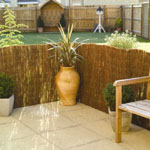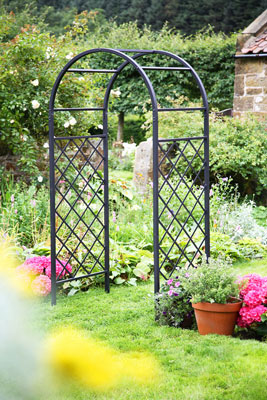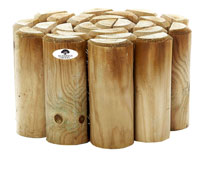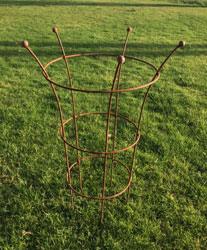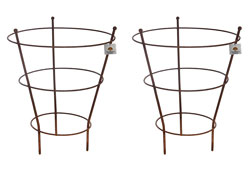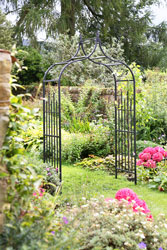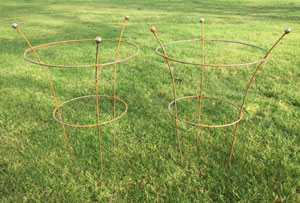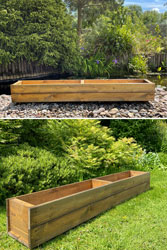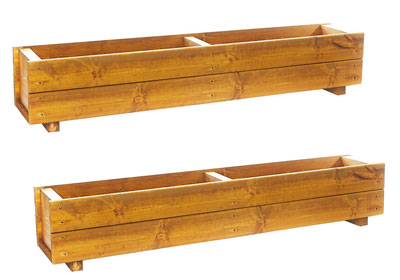
01757 28927301757 289273

UK Garden Supplies Bowland House, Ellerton, York, United Kingdom,
Herb Gardening
Raised Herb Beds
Garden Projects for Raised Beds
Raised beds are easy enough to create in any number of ways, but the first point is to decide how far raised you would like them to be, and this in turn will depend on the reason you want them raised in the first place.
Maybe you want them raised because someone who is wheelchair bound wants to tend them, in which case you will probably be looking at some 650-750 mms from ground level, depending on the person. Maybe you are just trying to get your veg out of your cold wet clay soil, which was our situation, my veg beds are 600 mm high which gave ample height for some hardcore drainage at the bottom with plenty of space for soil and compost above
Having decided on the height now consider the width if your bed is too high to get onto, you will have to be able to reach into the middle, so your width needs to be not much more than about 1200 mm wide. Otherwise the length and width of the beds are very much down to your own specific requirements.
Low beds are classically made from railway sleepers but this is a very expensive option and railway sleepers are heavy to manoeuvre on your own. A cheaper and easier way forward is to get some tantalised 50 x 50 mm timber and make some pegs about 400-450 mms long and knock these into the ground at the corners and then every 500 mms or so along each side; the get either tantalised gravel board or decking boards to screw to these pegs.
I have constructed my taller beds in the same way, using 75 x 50 mm tantalised uprights sunk into the ground a good 500 mms and decking timbers. I stapled polythene sheeting to the inside and then put about 100-150 mm rubble in the bottom for drainage and the filled with topsoil and compost. I covered the surface with black polythene in January which warmed the soil and killed some weeds. We have had a very successful set of crops this summer.
Raised beds are easy enough to create in any number of ways, but the first point is to decide how far raised you would like them to be, and this in turn will depend on the reason you want them raised in the first place.
Maybe you want them raised because someone who is wheelchair bound wants to tend them, in which case you will probably be looking at some 650-750 mms from ground level, depending on the person. Maybe you are just trying to get your veg out of your cold wet clay soil, which was our situation, my veg beds are 600 mm high which gave ample height for some hardcore drainage at the bottom with plenty of space for soil and compost above
Having decided on the height now consider the width if your bed is too high to get onto, you will have to be able to reach into the middle, so your width needs to be not much more than about 1200 mm wide. Otherwise the length and width of the beds are very much down to your own specific requirements.
Low beds are classically made from railway sleepers but this is a very expensive option and railway sleepers are heavy to manoeuvre on your own. A cheaper and easier way forward is to get some tantalised 50 x 50 mm timber and make some pegs about 400-450 mms long and knock these into the ground at the corners and then every 500 mms or so along each side; the get either tantalised gravel board or decking boards to screw to these pegs.
I have constructed my taller beds in the same way, using 75 x 50 mm tantalised uprights sunk into the ground a good 500 mms and decking timbers. I stapled polythene sheeting to the inside and then put about 100-150 mm rubble in the bottom for drainage and the filled with topsoil and compost. I covered the surface with black polythene in January which warmed the soil and killed some weeds. We have had a very successful set of crops this summer.
Herb Garden
Herbs How to use them
Apart from the traditional uses of herbs such as mint with potatoes, rosemary with lamb and basil with tomatoes there are many more original uses.
Mint is perhaps one of the most versatile and also usually plentifully available for anyone who grows it. Finely chopped add some to yogurt not only to take the heat away from any very spicy dish but also drizzled over boiled rice or couscous will add a wonderful contrast. It can make a very refreshing tea, an interesting sorbet, a very pleasant pickle or jelly (use apple as the base for this). You can also substitute rosemary for mint in most of these recipes.
Soft cheese can also become much more exotic and interesting when mixed with herbs, parsely, chives or marjoram will give you a start.
Vinegar is often spiced, you will certainly be familiar with the mint version to go with your lamb or pie and peas. Apart from use in pickling, these vinegars come into their own if you make your own salad dressings. Try garlic and tarragon (separately!).
Flavoured white sauces are also popular. We all know parsley sauce but give other herbs a try, I have not yet found one that doesn’t work. Start with rosemary or dill. In a similar way, the white sauce can be substituted with mayonnaise or butter to make different types of dressing. The only limit is your imagination.
Salads can be livened up considerably with the addition of herbs, as many as you like to give different layers of taste, but do stick to the youngest and tenderest of leaves as they will not be cooked. If you can add texture variations, for instance by adding some croutons fried in a herb infused oil so much the better.
If you want other ideas try herb omlettes, make your own bouquet garni, or even the dreaded pot pourri.
Apart from the traditional uses of herbs such as mint with potatoes, rosemary with lamb and basil with tomatoes there are many more original uses.
Mint is perhaps one of the most versatile and also usually plentifully available for anyone who grows it. Finely chopped add some to yogurt not only to take the heat away from any very spicy dish but also drizzled over boiled rice or couscous will add a wonderful contrast. It can make a very refreshing tea, an interesting sorbet, a very pleasant pickle or jelly (use apple as the base for this). You can also substitute rosemary for mint in most of these recipes.
Soft cheese can also become much more exotic and interesting when mixed with herbs, parsely, chives or marjoram will give you a start.
Vinegar is often spiced, you will certainly be familiar with the mint version to go with your lamb or pie and peas. Apart from use in pickling, these vinegars come into their own if you make your own salad dressings. Try garlic and tarragon (separately!).
Flavoured white sauces are also popular. We all know parsley sauce but give other herbs a try, I have not yet found one that doesn’t work. Start with rosemary or dill. In a similar way, the white sauce can be substituted with mayonnaise or butter to make different types of dressing. The only limit is your imagination.
Salads can be livened up considerably with the addition of herbs, as many as you like to give different layers of taste, but do stick to the youngest and tenderest of leaves as they will not be cooked. If you can add texture variations, for instance by adding some croutons fried in a herb infused oil so much the better.
If you want other ideas try herb omlettes, make your own bouquet garni, or even the dreaded pot pourri.


